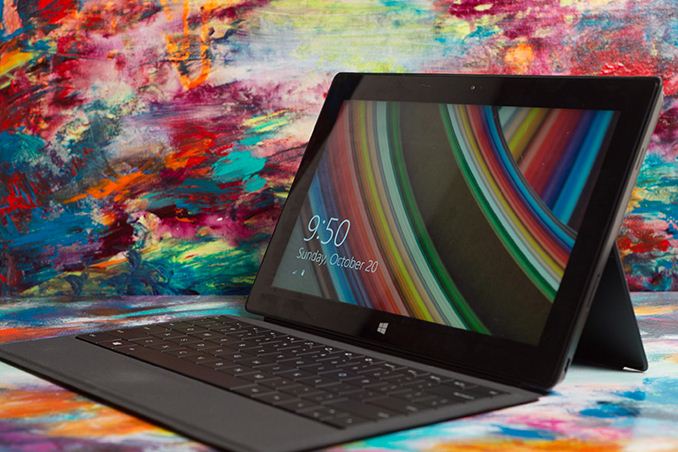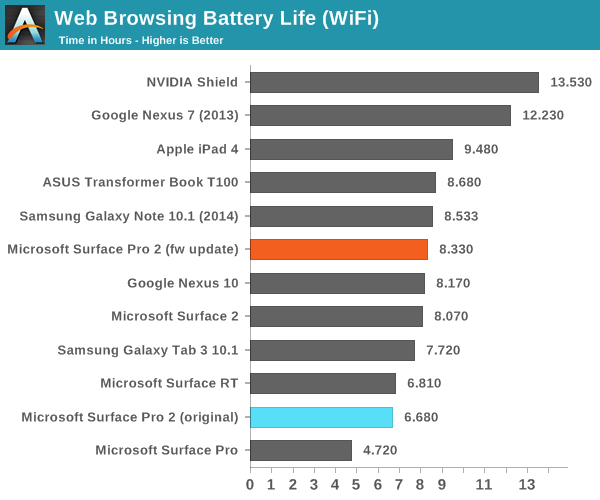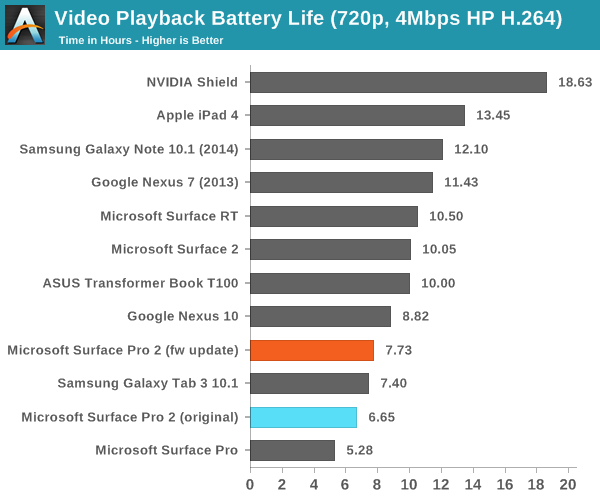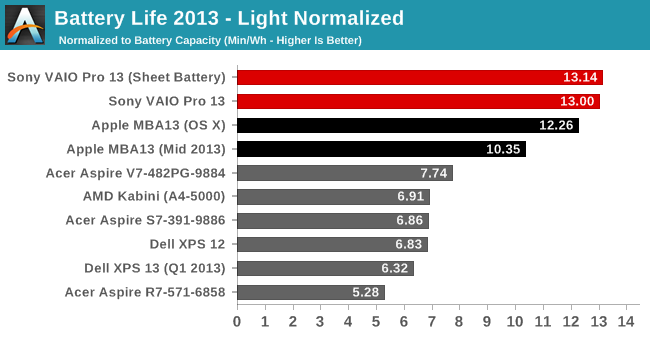Microsoft Surface Pro 2 Firmware Update Improves Battery Life
by Anand Lal Shimpi on November 2, 2013 1:47 AM EST- Posted in
- Tablets
- Microsoft
- Mobile
- Surface Pro 2

Shortly after general availability of the Surface Pro 2, Microsoft pushed out a firmware update that allowed the Marvell WiFi solution to drive down to even lower power states. I spoke with Microsoft after the update went live and immediately re-ran both of our battery life benchmarks on the Surface Pro 2. The improvement is significant.
As a recap, both of our battery life tests are run with the displays calibrated to 200 nits and running a fixed workload. A faster system doesn't mean more repetitions of a workload, just that the system enjoys more time idle.
The web browsing benchmark cycles through a series of desktop web pages at an aggressive interval until the battery dies.

In our web browsing battery life test, Surface Pro 2 now manages better battery life than Surface 2. Microsoft told me that their internal target was over 8 hours, and this firmware update brings it up to snuff via a nearly 25% increase in battery life.
Video playback also sees a boost since I test with WiFi enabled and connected to an active AP. Here we're playing back a rip I made of the last Harry Potter movie. It's a 720p 4Mbps high-profile H.264 video:

Haswell's video playback still doesn't seem all that power efficient. I've heard a rumor that this gets fixed in Broadwell though. The improvement on the video playback side is still reasonable at 16% over the numbers I originally ran.
A software update also rolled back the Surface Pro 2's video drivers to an earlier version that seems to have fixed the display corruption on wake issue as well. If you're wondering, Surface 2 didn't receive any similar battery life changing firmware update.
I chatted with Microsoft a bit about why Surface Pro 2 can't seem to deliver the same battery life in these tests as a 2013 MacBook Air. They correctly pointed to the litany of sensors included in Surface Pro 2, as well as the higher resolution display, active digitizer and capacitive touch all of which increase power draw over the MBA. While it's still true that we run into a lot of poorly optimized Windows notebooks as far as battery life is concerned, Jarred recently reviewed the new Sony VAIO Pro 13 that is a clear exception.

The VAIO Pro 13 is, for the first time in my memory, able to equal Apple's idle power efficiency if you normalize for battery capacity. The 2013 MBAs still managed to be more efficient under heavier workloads, but Sony at least showed it was possible to close the idle power gap.










62 Comments
View All Comments
mtalinm - Saturday, November 2, 2013 - link
I did my own battery test using a more realistic scenario for a Surface Pro user. Not just playing video or browsing the web -- you can do that with a regular tablet -- but doing Microsoft Office continuously with a little web browsing and music mixed in.I did the test a few days after I bought the SP2 and saw seven hours, almost exactly.
I don't know when this update arrived, but I will say that the battery life seems even better than when I first got it! I used to carry a charger around with my SP1, but I don't even bother anymore.
SP2 has all-day battery life as far as I'm concerned.
MarcSP - Saturday, November 2, 2013 - link
Is not really weird that Surface Pro 2 is getting better battery in web browsing than Surface 2? Isn't that anomaly worth some investigation or a short article to explain how can it be? Or is it normal?bountygiver - Monday, November 4, 2013 - link
Maybe ARM CPUs are not that power efficient when it comes to running a desktop-standard web browser.Krysto - Saturday, November 2, 2013 - link
Are you sure Microsoft isn't cheating you in benchmarks somehow, Anand?PNN - Saturday, November 2, 2013 - link
How do you cheat on battery life?skiboysteve - Saturday, November 2, 2013 - link
Do you test video using a desktop player or the video metro app? The video metro app uses a different pipeline and could have significantly different characteristics.it also might be worth drag-to-top closing everything but the video app (including the desktop)
hrrmph - Saturday, November 2, 2013 - link
It's great to see that MS is improving the product, but they dramatically limited its appeal by leaving telephony radios off of it (especially 4G data).I finally have some statistics on the #1 most wanted feature that users want in a mini-tablet:
- SD card reader - 26% of users with 9042 votes
- Phone functionality - 17% of users with 5912 votes
The poll was posted by Asus.
I doubt that the numbers would be much different for a full sized tablet.
Those two features are very much under-represented in the market offerings that exist today for phones, tablets, convertibles, and notebooks.
Imaginer - Saturday, November 2, 2013 - link
Limiting appeal by leaving built in cellular modems that are solely sourced to a provider?Let me plug in my own via USB (yes, they do exist - except not much of a hoopla because most tablet form factors forego an actual USB port and requisite driver options) and have that as an option instead. That way, I can change modems depending on the situation and have a lower cost device that potentially does not need to be bound by a contract upon device purchase.
hrrmph - Sunday, November 3, 2013 - link
"... built in cellular modems that are solely sourced to a provider?"No. Telephony radios that are compatible with Micro-SIM card slots are the standard. Unlocked is largely the global standard (except for the USA - why we cannot break that addiction I just don't know).
The best way to avoid trouble (read: onerous restrictions) is avoid buying any device from your telecom.
USB plug-in modem sticks: I've tried them on laptops. Workable, but awkward by comparison to a Micro-SIM slot. There is the physical breakage risk issue and the dodgy drivers that always seem to trash some other basic functionality (like proper shutdown of the machine it's plugged into).
Much better to have an OEM validated solution.
Again, I'm glad to see MS in the game and improving the product. More battery life is always important.
But, Apple isn't the real competition. Sammy is. The sooner that MS realizes that, then the sooner they will know what to do to fully compete (as in fully equip the devices, especially the flagships).
Tablets weren't just a revolution in down-sizing our computing devices. They were a revolution in how far we will carry them and how often we will open them up and use them in places we would rarely open up and use a laptop.
Mobile devices were meant to be able to be slung around, tossed on dashboards, flipped open and used at the smallest of whims... and keep ticking. That means full functionality. That means autonomy.
Cutting your flagship product off from having its own data connection doesn't seem wise at all. Battery life - no matter how good - isn't going to help solve that problem. But, adding telephony radios will.
Imaginer - Sunday, November 3, 2013 - link
"Mobile devices were meant to be able to be slung around, tossed on dashboards, flipped open and used at the smallest of whims... and keep ticking. That means full functionality. That means autonomy."By that definition, my Surface Pro 2 already can do this. There isn't a need for constant internet, and if I did had cellular service with a SIM card accepting modem, data plans will be exuberantly expensive.
And it is another device to add into the cost of an offered model - which Microsoft needs to add another configuration model that may change the costs overall for manufacturing and design. Another SKU to market, make, and support. They already have four with the Pro 2. Fitting in and redesigning the board within the turnaround time of the first Surface Pro 1 to now would delay the Pro 2 even further (from electronics validation to FCC regulatory validation)
I take this current compromise. When in a city or town, I can find a Wifi spot. If I am out in a remote wilderness area, I rarely am able to get cellular coverage anyways, making a built in cellular modem worthless. Many people tether their phone as a Wifi hotspot, making another modem in a tablet or laptop even more pointless.